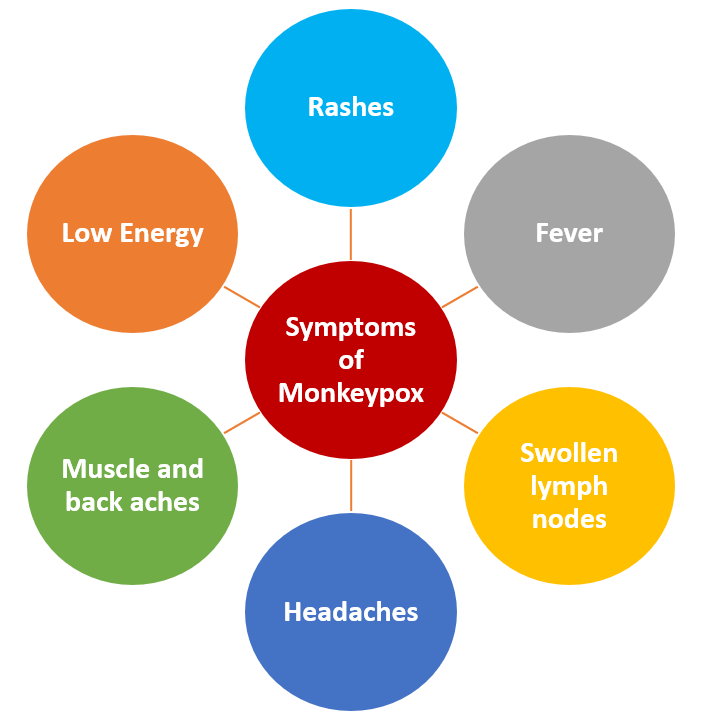Monkeypox Symptoms, Treatment, Diagnosis, Cases and How to Prevent Monkeypox
2022-08-22 | Priyanka Chaudhary
The first indigenously-developed RT-PCR kit for testing monkeypox has been launched at the Andhra Pradesh Medtech Zone (AMTZ). The kit has been developed by Transasia Bio-Medicals.
Monkeypox has been tagged as a public health emergency of international concern (PHEIC) by World Health Organisation. The other two public health emergencies declared by WHO are- Coronavirus pandemic and efforts to eradicate polio.
Monkeypox has been reported as endemic in many central and western African countries like Cameroon, Central African Republic, Cote d’Ivoire, the Democratic Republic of the Congo, etc. It has also been reported in certain non-endemic countries, e.g., USA, UK Belgium, France, Germany, Italy, Netherlands, Portugal, Spain, Sweden, Australia, Canada, Austria, Canary Islands, Israel and Switzerland.
What is Monkeypox?
Monkeypox (MPX) is a viral zoonotic disease in which the symptoms are similar to smallpox. Although the disease is clinically less severe. It is caused by the monkeypox virus which is a member of the Orthopoxvirus genus in the family Poxviridae.
The disease is called monkeypox as it was first found in colonies of monkeys in 1958 and was later found in humans in 1970.
According to WHO reports, the majority of cases were reported from the European regions and others including Africa and America among the five WHO Regions. The case fatality ratio has been around 3–6%.
In India, a total of four cases of Monkeypox have been reported as on 26 July 2022. Delhi reported its first case on 24 July wherein a 34-year-old male tested positive and three other cases have been reported in Kerala.
How does Monkeypox get transmitted?
The disease can transfer from animal to human through direct contact with the blood, bodily fluids, or cutaneous or mucosal lesions of infected animals. It can also be transmitted to humans through a person or animal who is infected by the virus and also spread through material contaminated it.
Various animal species have been identified as susceptible to the monkeypox virus-like rope squirrels, tree squirrels, Gambian pouched rats, dormice, non-human primates, etc.
Close contact with respiratory secretions, skin lesions of an infected person or recently contaminated objects can cause human-to-human transmission. It is also possible to become infected from breathing in skin flakes or viruses from clothing, bedding or towels. This is known as fomite transmission.
In short, monkeypox can spread through:
- Skin to skin contact
- Face to face contact
- Mouth to skin contact
- Touching infected bedding, towels, clothing or objects
What are the symptoms of Monkeypox?
The symptoms of the virus usually show from 6 to 13 days but can range from 5 to 21 days. Some of the symptoms are:
According to WHO, in about 95% of cases, the rashes affect the face while in 75% of cases, it affects the palms of the hand and soles of the feet. The rash can be found on the face, palms of the hands, soles of the feet, eyes, mouth, throat, groin, and genital and/or anal regions of the body. Lesions begin flat, then fill with liquid before they crust over, dry up and fall off, with a fresh layer of skin forming underneath.
How can we prevent Monkeypox?
- Raising awareness of risk factors and educating people about the disease so as to reduce exposure of the virus.
- As per the guidelines issued by the Ministry of Health, international passengers should avoid close contact with sick people, contact with dead or live wild animals and others.
- Isolate infected patients at home
- Avoid contact with any materials that have been in contact with the infected person
- Practice good hand hygiene after contact with an infected person
- Use masks and gloves when taking care of the infected person
- Affected person should avoid close contact with people having very low immunity, children and pregnant women
How can you recover from Monkeypox at home?
- Take in lot of fluids, eat and sleep well. Take medicine for fever and pain if required.
- Don’t scratch your rashes; keep them dry and covered.
- Take warm baths with baking soda/Epsom salt and keep the rash clean with sterilized water.
- Lidocaine can be applied to oral lesions to relieve pain.
- Stay connected with people and do things that relaxes your mind while in isolation.
- If your sharing room with another person, keep your rashes covered; avoid touching each other; keep windows open and wear medical masks.
Is there any vaccine to prevent monkeypox?
According to WHO, a smallpox vaccine was recently approved which may also be useful for monkeypox. Only people who are at risk should opt for vaccination. WHO does not recommend mass vaccination at this time.
How can the virus be diagnosed?
As per WHO, detection of viral DNA by polymerase chain reaction (PCR) is the preferred laboratory test for monkeypox.
Share Blog






Comments